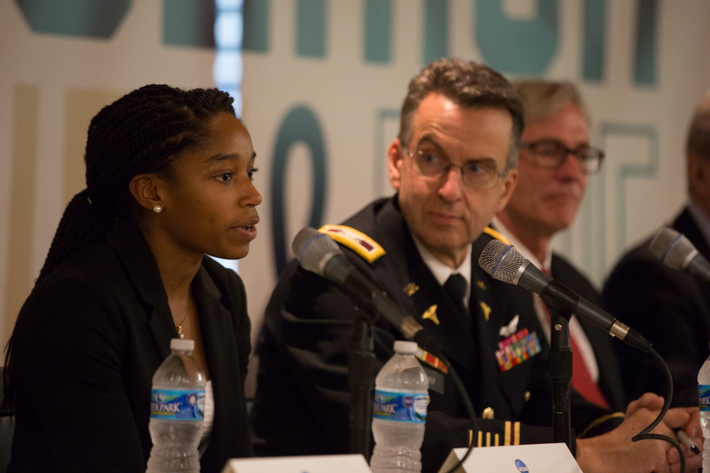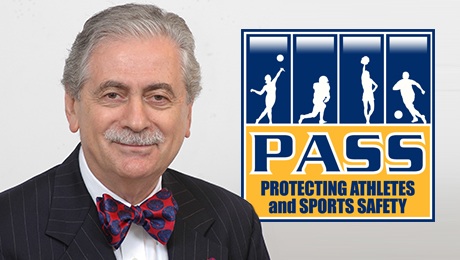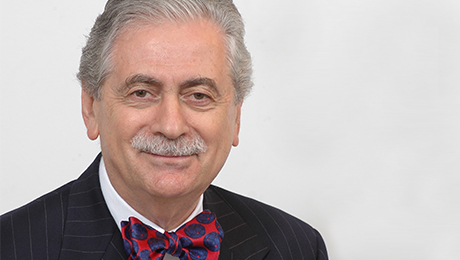Lauren Chase quickly bounced back after she suffered her first concussion during freshman year on the University of Maryland-Baltimore County women’s basketball team. The symptoms from her second concussion—dizziness, light sensitivity and headaches—lasted for a week.
But after the senior point guard transferred to George Washington University in spring 2013, another player’s elbow collided with her head during practice. And then the headaches didn’t go away.
 |
| Lauren Chase, senior |
“I had headaches every day. Throughout the rest of the summer, I was out from all activity,” Ms. Chase said to an audience in the Charles E. Smith Center on Thursday. The petite student athlete paused. Tears streamed down her face.
“Being an athlete, you’re a competitor,” Ms. Chase said. “It’s hard to not be out there with your team, especially when you really want to be tough.”
Ms. Chase reflected on the consequences of concussions during a panel discussion hosted by GW and the NCAA.
The event was held in conjunction with the launch of the “Mind Matters Challenge”—a new $4 million educational initiative sponsored by the NCAA and the U.S. Department of Defense. The program will provide grants up to $400,000 for research that would improve the understanding of how to effect change regarding concussions in the often-macho cultures of sports and the military. Awards up to $100,000 will fund educational programming.
The challenge is part of the NCAA-Department of Defense Grand Alliance, a $30 million program to change attitudes and behavior in young adults about concussions arising from sports- and military-related activities.
Sports-related concussions captured the national spotlight after lawyers representing more than 5,000 retired football players filed a class-action lawsuit against the NFL, alleging the league had hidden the long-term impacts related to repeated blows to the head.
The NCAA released new football hitting and concussion safety guidelines this summer, including limiting live football contact practices to two per week and requiring that team medical directors have clear and transparent authority when caring for injured players. And with a grant from the NFL, the Centers for Disease Control and Prevention (CDC) launched a free online course for health care professionals to identify and appropriately manage young athletes with concussions.
Concussions are sometimes called “invisible injuries,” explained NCAA Chief Medical Officer Brian Hainline, because although they have long-term health implications, they often go unidentified or untreated. Some athletes do not think the injuries are serious enough to tell an adult or fear that they will lose playing time if they report symptoms.
Similarly, traumatic brain injuries have been labeled the “signature injury” of the Iraq and Afghanistan wars, with an estimated 320,000 reported cases, according to the Brain Injury Association of America.
“Right now, no one has been able to demonstrate what is the best way to change the culture around concussion,” Dr. Hainline said. “Concussions need to be taken with the same seriousness and have the same transparency as an ACL injury, as a back injury, as an alcohol problem. So we’re determined to bring that all out in the open.”
When the pounding in Ms. Chase’s head did not disappear, she visited a neurologist, who told her she was probably having “migraine issues.” But a second doctor confirmed that the headaches were more likely related to her multiple concussions and advised her to sit out the rest of the basketball season.
Though the diagnosis caused Ms. Chase to miss the entire 2013-14 season at GW, she said she was grateful. Doctors officially cleared her to play in July, and she is “happy to be back.”
“As much as it hurts to take a break, it is something that I really, really appreciated and needed. You want to be out there with your team. But I learned that rest is something that I really needed,” Ms. Chase said. “A lot of student athletes are pushed to the edge, where they have the mindset that they have to be out there.”
She said the experience taught her about the importance of being honest with her doctors, coachers, trainers and most importantly—with herself. Ms. Chase will graduate from GW a semester early. In the spring, she will begin a master’s program in rehabilitation counseling with a concentration in traumatic brain injuries. She said she hopes to help other student athletes who have suffered from multiple concussions.
Experts at Thursday’s panel—including representatives from the CDC and Prevention and Seattle Children’s Hospital—stressed the importance of “reducing the stigma” associated with concussions and also the need for more scientific evidence about the effectiveness of educational programs. And while there is still much more work to be done, experts said awareness about the seriousness of concussions is growing.
Further, GW Professor Eliot Sorel said he hopes that greater conversation about concussions will help empower young people to feel safe while playing sports rather than shy away from athletics. Dr. Sorel, a professor in the Milken Institute School of Public Health and the School of Medicine and Health Sciences, is the co-chair on the National Council on Youth Sports Safety.
“We want our kids not to fear being involved in sports. We are at the moment though, on a fear rampage unfortunately. And we need to reach a balance,” Dr. Sorel said. “We cannot forget the tremendous assets that sports has for kids—and not only for kids—but throughout the life cycle.”

(From left) Col. Dallas Hack, U.S. Army brain health research coordinator; Brian Hainline, NCAA chief medical officer; Eliot Sorel, professor of global health in the Milken Institute School of Public Health, professor of psychiatry and behavioral sciences in the School of Medicine and Health Sciences.





